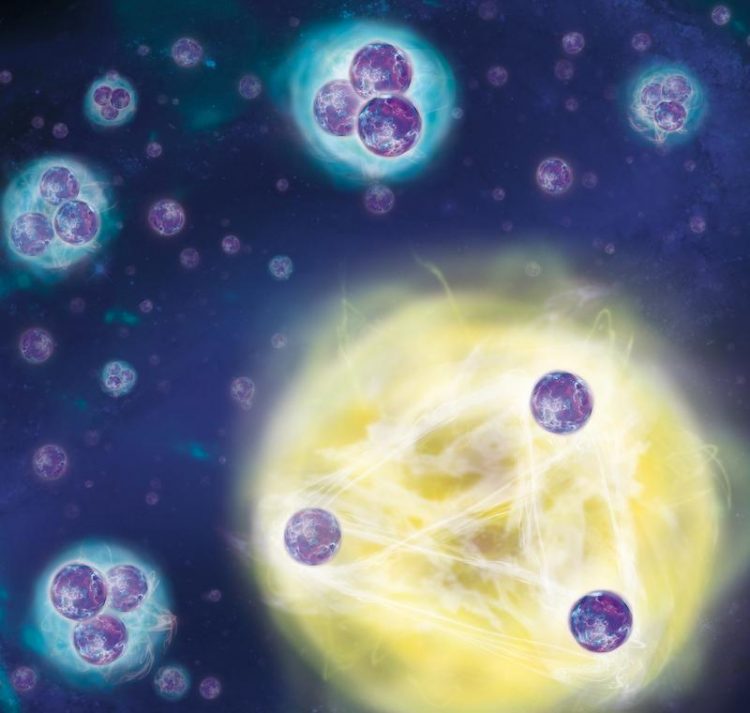Quantum Trimer – From a Distance

The mysterious Efimov scenario IQOQI/Harald Ritsch
Eight years ago Rudolf Grimm’s research group was the first to observe an Efimov state in an ultracold quantum gas. The Russian physicist Vitali Efimov theoretically predicted this exotic bound state of three particles in the 1970s.
He forecast that three particles would form a bound state due to their quantum mechanical properties, under conditions when a two-body bound state would be absent. What is even more astounding: When the distance between the particles is increased by factor 22.7, another Efimov state appears, leading to an infinite series of these states. Until now this essential ingredient of the famous scenario has remained elusive and experimentally proving the periodicity of the famous scenario has presented a challenge.
“There have been some indications that particles continuously create three-body states if the distance is increased by this factor,” says Rudolf Grimm from the Institute of Experimental Physics of the University of Innsbruck and the Institute of Quantum Physics and Quantum Optics of the Austrian Academy of Sciences. “Proving the scenario was very difficult but we have finally been successful.”
Bound in great distance
Ultracold quantum gases are highly suited for studying and observing quantum phenomena of particle systems experimentally as the interaction between atoms are well tunable by a magnetic field. However, Rudolf Grimm’s research group got very close to the limits of what is possible experimentally when they had to increase the distance between the particles to one micrometer to be able to observe the second Efimov state. “This corresponds to 20,000 times the radius of a hydrogen atom,” explains Grimm.
“Compared to a molecule, this is a gigantic structure.” This meant that the physicists had to be particularly precise with their work. What greatly helped the researchers in Innsbruck was their extensive experience with ultracold quantum gases and their great technical expertise. Their final result shows that the second Efimov state is larger than the first one by a factor of 21.0 with a measurement uncertainty of 1.3. “This small deviation from the factor 22.7 may be attributed to the physics beyond the ideal Efimov state, which is also an exciting topic,” explains Rudolf Grimm.
New research area
The scientific community’s interest in this phenomenon lies in its universal character. The law is equally applicable to nuclear physics, where strong interaction is responsible for the binding of particles in the atomic nucleus, and to molecular interactions that are based on electromagnetic forces. “Interaction between two particles and between many particles is well studied,” says Grimm. “But we still need to investigate and learn about phenomena that arise from the interaction between only a few particles. The Efimov states are the basic example for this.” The joint work of Rudolf Grimm’s team and the British theoretical physicist Jeremy M. Hutson has been supported by the Austrian Science Fund. The results are now published in the journal Physical Review Letters.
Publication: Observation of the Second Triatomic Resonance in Efimov's Scenario. Bo Huang, Leonid A. Sidorenkov, Rudolf Grimm, Jeremy M. Hutson. Phys. Rev. Lett. 112, 190401 (2014) DOI: http://dx.doi.org/10.1103/PhysRevLett.112.190401, arXiv: http://arxiv.org/abs/1402.6161
Contact
Univ.-Prof. Dr. Rudolf Grimm
Institute for Experimental Physics
University of Innsbruck
phone: +43 512 507-52410
email: rudolf.grimm@uibk.ac.at
web: http://www.ultracold.at
Christian Flatz
Public Relations
University of Innsbruck
phone: +43 512 507 32022
email: christian.flatz@uibk.ac.at
http://physics.aps.org/articles/v7/51 – Physics Viewpoint: Giant Efimov States Now Observed
http://www.ultracold.at – Ultracold Atoms and Quantum Gases
Media Contact
All latest news from the category: Physics and Astronomy
This area deals with the fundamental laws and building blocks of nature and how they interact, the properties and the behavior of matter, and research into space and time and their structures.
innovations-report provides in-depth reports and articles on subjects such as astrophysics, laser technologies, nuclear, quantum, particle and solid-state physics, nanotechnologies, planetary research and findings (Mars, Venus) and developments related to the Hubble Telescope.
Newest articles

First-of-its-kind study uses remote sensing to monitor plastic debris in rivers and lakes
Remote sensing creates a cost-effective solution to monitoring plastic pollution. A first-of-its-kind study from researchers at the University of Minnesota Twin Cities shows how remote sensing can help monitor and…

Laser-based artificial neuron mimics nerve cell functions at lightning speed
With a processing speed a billion times faster than nature, chip-based laser neuron could help advance AI tasks such as pattern recognition and sequence prediction. Researchers have developed a laser-based…

Optimising the processing of plastic waste
Just one look in the yellow bin reveals a colourful jumble of different types of plastic. However, the purer and more uniform plastic waste is, the easier it is to…


